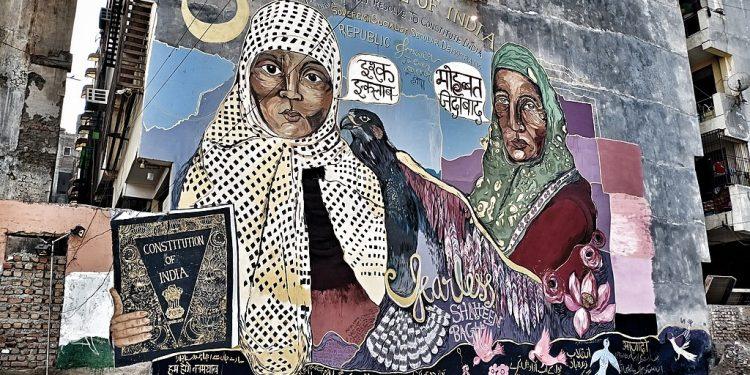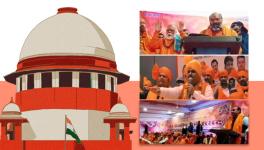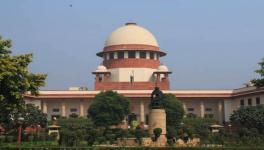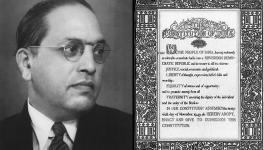Citizen to Criminal: Citizenship Determination in India and the Limits of Due Process

Graffiti in Shaheen Bagh, Source: Common Creative
The three-pronged idea of citizenship germinating at the constitutional moment as status, rights and identity, have undergone significant transformations since the Constitution was drafted. In this Special Issue on Citizenship, we take the occasion of the Republic Day to look back at the historical and material conditions surrounding the citizenship debates in the Constituent Assembly, as well as in the everyday lives of ordinary citizens who negotiated, resisted, or facilitated legal belongings with the state.
Criminal law offers most individuals a path back to the community, but statelessness results in permanent expulsion from the body politic of the nation-state. Foreigners Tribunals in India are effectively excluding entire communities from legality, with no way back in, writes DARSHANA MITRA, a co-founder of Parichay and guest faculty at the West Bengal National University of Juridical Sciences. This is the fourth article in The Leaflet’s Special Series on Citizenship edited by Jhuma Sen.
——–
IN 2005, the Supreme Court of India stated that persons subject to proceedings for identification and deportation of foreigners are not entitled to the protections under Article 21 of the Constitution of India(Sarbananda Sonowal v Union of India), “In a criminal trial where a person is prosecuted and punished for commission of a crime and may thus be deprived of his life or liberty” the Supreme Court said, “it is not enough that he is prosecuted in accordance with the procedure prescribed by law but the procedure should be such which is just, fair and reasonable.”
However, according to the Court, proceedings for the identification and deportation of foreigners are not bound by such requirements, as the person is not being deprived of his life or personal liberty.
The Supreme Court also blamed migration for insurgency in Assam and the rise of Muslim militant groups, and characterised illegal migration as a threat to national security, and as “external aggression” within the meaning of Article 355 of the Constitution of India.
The Supreme Court’s remarks in Sarbananda Sonowal are consistent with a long tradition of conceptual confusion in Indian law. The categories of citizen, foreigner, and criminal, and the legal implications of viewing an individual as one or the other has been consistently lost on legislators and members of the judiciary alike. The cost of this confusion is borne by precarious citizens.
Also Read: Citizenship’s Rule of Exception
“One of the most surprising aspects of our experience with stateless people,” wrote Hannah Arendt in 1951, “has been the fact that it seems to be easier to deprive a completely innocent person of legality than someone who has committed an offense.”
Arendt was arguing that not only do the stateless lose all rights, but it is also easier to render someone stateless and deprive them of all rights than to convict them of a crime and deprive them of some rights. This is evident in the ease with which Foreigners’ Tribunals in India strip persons of their citizenship.
From Citizen to Foreigner
Neither the Constitution of India nor the Citizenship Act 1955 define who a citizen is. Both documents only tell us how citizenship can be acquired. The closest we have to a definition is Section 2(a) of the Foreigners Act, which defines a foreigner as “a person who is not a citizen of India”.
Thus, proof of citizenship is not only tied to proof of its acquisition but also to prove that one is not a foreigner. Citizenship determination in India in many ways illustrates this slippage between the categories of citizen and foreigner (and hence stateless). This is evident in the ease with which Foreigners’ Tribunals in India strip persons of their citizenship.
Cases are brought before the Tribunals either through investigation by the Border Police in Assam, or by the Election Commission, marking persons as Doubtful (D) Voters whose citizenship is in question.
The Foreigners Tribunals were set up in Assam under the Foreigners Act, 1946 and the Foreigners (Tribunals) Order, 1964, after the Supreme Court, in Sarbananda Sonowal, struck down the constitutionality of the Illegal Migrants (Determination by Tribunal Act) 1983 (IMDT Act).
The IMDT Act provided for special tribunals for the identification of foreigners in the state of Assam and placed the burden of proof on the state to establish that a person was not a citizen. It was successfully argued before the Supreme Court that this, and other procedural safeguards in the Act, made it difficult for the state to address unchecked cross-border migration to Assam.
The Supreme Court also rejected the contention that persons whose citizenship was in question were entitled to the protection of Article 21 and a fair, just and reasonable trial, as provided for in the tribunals set up under the IMDT Act.
Cases are brought before the Tribunals either through investigation by the Border Police in Assam, or by the Election Commission, marking persons as Doubtful (D) Voters whose citizenship is in question.

Source: Sabrang
Establishing Documentary Citizenship
Persons appearing before Foreigners’ Tribunals are expected to establish meticulous records dating back before the cut-off date in Section 6A of the Citizenship Act, ie, March 25, 1971 to establish their citizenship. Unlike the IMDT Act, Section 9 of the Foreigners’ Act places the burden of proof on the person to establish that they are citizens of India.
Moreover, Tribunals are free to develop their own procedures, and it is well documented that many foreigners’ tribunals frequently rely on the reversed burden of proof, and their procedural autonomy to deny litigants even the most of assistance.
Also Read: CAA 2019 and the Spectre of National Citizenship
Tribunals are often unforgiving of minor inconsistencies in documentary evidence, and routinely reject documents because of spelling mistakes. Tribunals frequently refuse to even issue summons to witnesses appearing on behalf of the litigant, making it difficult for the litigant to make an effective case for their citizenship. Because these are not criminal proceedings, safeguards such as Section 311 of the Criminal Procedure Code, 1973, which grants criminal courts the authority to summon any witness, do not apply. This arbitrariness continues despite a Gauhati High Court decision upholding the right to fair investigation, trial and fair procedure before a Foreigners’ Tribunal.
Unlike criminal law, which seeks to minimize wrongful conviction, Foreigners’ Tribunals seek to maximize the number of declared foreigners, a process incentivized by performance assessment that depends on the number of persons declared foreigners. Foreigners Tribunals also frequently pass ex-parte orders declaring persons to be foreigners, without any application of mind or affording the person a chance to make an effective claim for citizenship. This is a reversed Blackstone’s ratio that prioritises the State’s interests in identifying foreigners, even at the cost of rendering some citizens stateless.
This slippage between foreigners and citizens is evident in legislative debates as well. The introduction of the Citizenship (Amendment) Bill, 1986, which sought to restrict birthright citizenship under Section 3 of the Citizenship Act 1955 to only persons born of an Indian citizen, saw heated debates on the categories of citizen and foreigner. “It seems”, said Somnath Chatterjee, one of the more vocal opponents of the Bill, “that sort of an immigration law is being introduced in this country in a back-handed manner, by amending the citizenship law in the manner it is being done”.
Also Read: ‘Sindh is not a piece of territory’: Sindhi belonging in India
Somnath Chatterjee was accusing the government of using the citizenship law to deal with the problem of immigration law, instead of enforcing immigration control, and that in attempting to discourage immigration, the Bill would actually result in rendering stateless those who would, but because of the accident of their birth, be citizens of India.
From Foreigner to Criminal
Once a citizen is declared to be a foreigner, criminality is imputed to them. Seen as security threats and potential criminals, the punitive elements of immigration law, e.g. detention, are weaponised to contain them. As the Supreme Court’s comments in Sarbandanda Sonowal tell us, courts often rely on the conceptual slippage between the categories of foreigner and criminal to justify harsher and punitive legal frameworks to deal with foreigners.
By imputing criminality (migrants are criminals) without alleging specific criminal acts, courts and Foreigners Tribunals are reifying the unjust asymmetry at the heart of the process.
This is typical of crimmigration regimes, that are characterised by both an increased criminalisation of immigration offences, and a discursive overlap between the categories of immigrant and criminal. This, argues Juliet Stumpf, is because both criminal and immigration laws are based on distinctions between insiders and outsiders, unlike most other areas of law that are to do with relationships and conflicts between individuals. While criminal law seeks to separate the innocent from the guilty, immigration law enforces a separation between the included (citizens and legal migrants) and the excluded (illegal migrants).
This “punitive bent” is reflected in the use of detention. Paresh Hate argues that immigration detention is actually part of “cultures of penalty” in citizenship and immigration law that have travelled from empires to their former colonies. In India, punitive measures to deal with immigration pre-date independence. Section 3(2)(e) of the Foreigners Act, 1946 provides for detention of persons declared to be foreigners. While detention is supposed to be simply a precursor to removal or deportation, Abantee Dutta locates it as a form of “coercive confinement” which exceeds criminal penalties by denying detainees the rights to parole and remission available to convicted criminals.

This discursive overlap between the categories of criminal and foreigner/immigrant is then used to justify “zero tolerance” approaches to migration. For example, in Sarbananda Sonowal, the Supreme Court of India argued that migration was a threat to national security and as “external aggression” within the meaning of Article 355 of the Constitution of India, thus imposing a constitutional mandate on the Government of India to take all measures for protection of the state of Assam from external aggression and internal disturbances. Sujatha Ramachandran in her work on crimmigration control in India shows how courts across India regularly deny bail and impose harsh fines on persons identified as illegal migrants.
From Insider to Outsider
“Jurists” wrote Hannah Arendt in 1951, “are so used to thinking of law in terms of punishment, which indeed always deprives us of certain rights, that they may find it even more difficult than the layman to recognize the deprivation of legality, i.e. of all rights, no longer has a connection with specific crimes”. Crimmigration regimes in India, of which Foreigners Tribunals are a part, treat foreigners as potential criminals, to justify the use of punitive measures against them. However, because the path from citizen to a foreigner has been so dramatically shortened by Foreigners’ Tribunals, the result is the criminalisation of precarious citizens, without providing adequate due process safeguards.
By imputing criminality (migrants are criminals) without alleging specific criminal acts, courts and Foreigners Tribunals are reifying the unjust asymmetry at the heart of the process. Citizens become foreigners in the absence of due process, and then are subjected to punitive measures and treated as potential criminals. However, while criminal law allows most individuals a path back to the community, statelessness results in permanent exclusion from the body politic of the nation-state.
The slippery slope between the categories of citizen, foreigner, and criminal is resulting in the complete deprivation of rights of persons who claim to be insiders but are being treated as outsiders.
(Darshana Mitra is a co-founder of Parichay, a collaborative legal aid clinic set up to assist persons excluded from the NRC in Assam. She is also guest faculty at the West Bengal National University of Juridical Sciences, where she teaches Citizenship and Immigration Law. Views are personal.)
The article was originally published in The Leaflet.
Get the latest reports & analysis with people's perspective on Protests, movements & deep analytical videos, discussions of the current affairs in your Telegram app. Subscribe to NewsClick's Telegram channel & get Real-Time updates on stories, as they get published on our website.
























